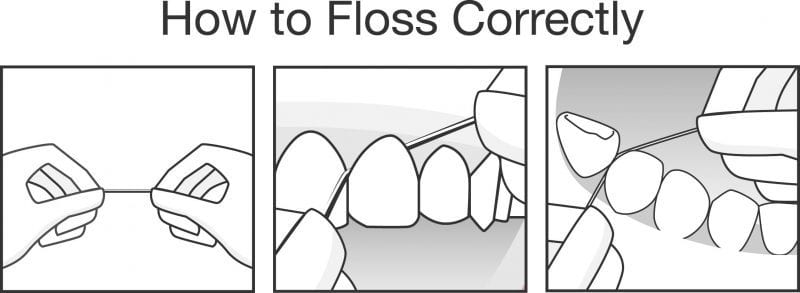It’s common knowledge that it’s essential to brush and floss every day, but do you know the proper techniques for flossing? These tips can help you learn how to floss properly.
What is the right way to floss your teeth?
Flossing your teeth at least once a day is highly recommended by most dentists. Proper flossing removes plaque and food particles under the gumline and between your teeth—places where it’s impossible for your toothbrush to reach.
How to floss:
Wash your hands before you reach for the floss. Then proceed with the following steps:
- Cut a piece of dental floss about 18 inches long. It may seem like a lot, but it’s important to use a clean segment as you floss around each tooth.
- Wrap the majority of the floss around each middle finger. Leave an inch or two unwound to use for flossing your teeth.
- Hold the floss between your thumbs and index fingers, making sure it is taut. Guide it gently between your teeth.
- When the floss meets the gumline, curve it into a C shape against your tooth. Gently slide it into the space between the tooth and gum. Do not force the floss into the gums. This may cut or damage gum tissue.
- Hold the floss firmly against your tooth. Gently rub the side of the tooth, moving the floss up and down, away from the gum. Continue using this technique on all of your teeth.
- Use clean sections of floss for each tooth. Remember to include the backside of your last tooth.

Which type of floss should you use?
Nylon floss: Available waxed and unwaxed, and in a variety of flavors, nylon floss is comprised of many strands of nylon wound together. It can often shred or rip, most commonly between teeth with tight contact points or multiple restorations.
PTFE floss: Although it is more expensive, many people prefer single filament (PTFE) floss. Also known as dental tape, it slides easily and comfortably between teeth. It is practically shred-resistant.
Both types of floss are effective for removing plaque and debris. Talk to your dentist about what type of dental floss will best suit your needs. If you have questions about how to floss, make sure to ask your dentist or hygienist about proper technique at your next visit.
Good oral hygiene affects your overall health and wellness
A dental discount plan from DentalSave can help to make it affordable to take good care of your oral health by saving you up to 50 percent on dental cleanings and procedures. The average cost of a periodic oral examination is $52. With your DentalSave membership you pay less than $10/month.




